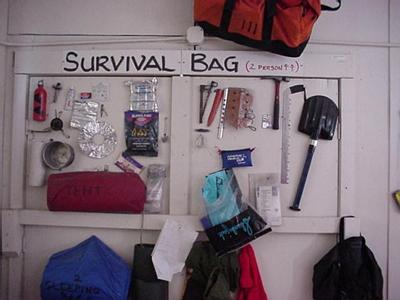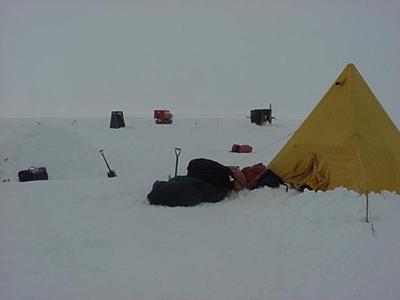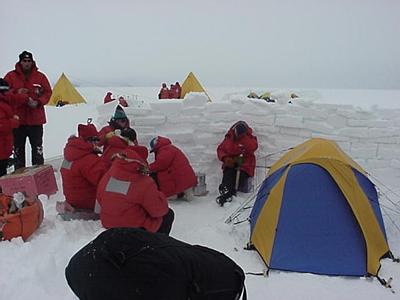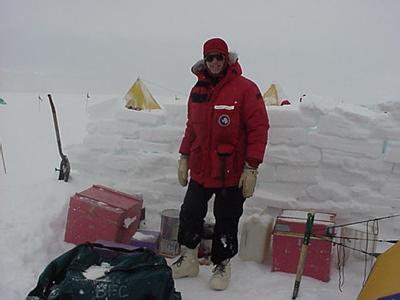
|
|
12 November, 1999
Friday November 12, 1999
Survival training time had arrived. Everyone says it is fun, but bring all
your ECW gear. Sounds good to me. Woke up about 0530 hours and went to
Crary Lab to check and send email. I had a nice note from my Darcy, wishing
me well on my adventure in the field. Thanks Darcy. I needed that.
Grabbed a quick breakfast with as much fatty foods as possible. Need the
old calories if you want to stay warm. Did a bag drag up to the Field
Safety Training Program (FSTP) building and got there as it was just
starting to snow. Since I was about 40 minutes early I waited outside in
the snow. About 10 minutes to 0900 hours more and more people showed up,
until by the time we were all settled in there were 22 of us. This was a
huge class, because there were 10 KIWI soldiers/airmen, most of whom had
flown in with us last Monday. I would guess, with the exception of a couple
of guys who were in charge, their average age has to be about twenty five.
These Kiwis were cool and fun loving.
The first thing we were asked to do was to identify who we were and what we
were doing here. There were basically three science groups here. Five
people from Dr. Bess Ward's group who would be studying the "Control of
Denitrification in a Permanently Ice-Covered Antarctic Lake: Potential for
Regulation by Bioactive Metals (One of the team members is Sharon Harris a
fellow school teacher and a member of 1999-2000 TEA Dream Team, Teachers
Experiencing the Antarctic and Arctic program that sends teachers to both
poles to become research assistants and to spread the word about the life
and sciences that happen at the poles.) There was Dr. Bert Yankielin from
the ITASE (International Trans-Antarctic Science Expedition) group and there
was me who will be working with Dr. Berry Lyons' group studying the
chemistry of the streams, lakes and glaciers of the Dry Valley. The
remaining four were various ASA people who would be going out into field
camps. The rule is, you go to a field camp, you must go to filed Safety
Training (AKA Happy Camper's School).
There were two instructors Chas, a retired military officer, and a young guy
Brennen, a nature guide and survival expert. Both probably knew more about
survival then 99% of the people on the ice. The plan was this. We would be
driven out onto the Ross Ice Shelf, a gigantic sheet of snow miles long and
wide and some 500 to 800 feet which that spreads from the land out onto the
ocean, and there we would spend the rest of today, tonight and all day
tomorrow. We received about a 45-minute lecture explaining the 2 man
survival kits contents. We wear told to wear the various layers of our ECW
(to keep warm and then be able to shed layers as we began to work and got )
sweaty. We were told we would bring more then enough food and water for the
expected tour and then we were given time to use the bathroom, the last
facility for the next two days. I never saw 22 people all decide at one time
that Nature doth calleth. By the time we all had our last chance at indoor
plumbing the wind was hollowing and the snow continued to fall. All of our
drag bags had been left outside so we were instructed to help bring the
food, water and camping materials outside with our gear and wait there until
our chariot showed up. We were not out there more then ten minutes when this
huge orange machine with sort of a swivel in the middle and multiple tracks,
similar to a tank, arrived. This machine known as a "Nod-well", was loaded
with all the gear and 22 very excited (some were obviously apprehensive)
bodies and the two instructors. We were packed tighter here then we were on
the C-141, if that's possible.
The Nod-well lumbered out of McMurdo past the NZ camp known as Scott Base,
out on the sea ice for a bit and then several miles I think it would be to
the west. We could see William's (Willie) Field off in the distance when the
wind dropped a little. I'm guessing we went out between 8 and 12 kilometers
(How many miles? For those of you in my classes how many centimeters, in
proper powers of ten please?)
By the time we got to our destination the windows on the Nod-well we opaque
with frost. Chas had driven and Brennan road with us so as soon as Chas
tapped the back door, signaling it was OK to exit, Brennan popped the hatch
and we jumped to the ground. Other then the Nod-well idling the only sound
was that of the wind. As I looked around I saw three structures.
Immediately next to the Nod-well was this trailer truck body (I think they
call it a conax???) then off in the distance, maybe 50 meters was a
Jamesway, an old, Korean war vintage, type building. It has the appearance
of a cylinder cut longitudinally (sort of arched). If you have seen MASH,
it is one of those that Hawkeye etc. use to operate in. The third structure
was a sort of an A-framed box, small it looked to be about four feet wide
and thick at the ice edge and maybe 8' tall, and it was located probably 20
meters beyond the Jamesway. As you looked around across the great expanse
of different shades if whiteness you could see bamboo poles with either red
or green flags attached. These marked the safe travel zones. We were told
there were two other colored flags to be aware of: black which denotes
danger (such as a crevasse that might have opened up, such as one about 4 km
from this site); and a yellow flag. More on the Yellow Flag latter.
When the Nod-well was shut off we could at least hear what Chas was saying.
The conax held our sleep gear which would consist of two, looked like
neoprene pads about 11/2 inches thick, a very heavy down sleeping bag and a
poly-fleece sleeping bag liner. Chas said the Jamesway is where we would
have lunch and some more classes. The little A-framed building turned out
to be an outhouse specifically for defecation in general or for urination
by females. You ask, what about you guys? Remember the Yellow Flag, well
that marked the only spot, other then the outhouse, where men were to
urinate. Great country America. Gee that's right, it's not America it is
Antarctica and "when in Rome do as the Romans do".
We trudged through the snow, most of it as hard as rock, until you came to a
spot where it could, and did drift. Then oops, up to you thighs in light
powdery snow.
The Jamesway was very Spartan. There was a table at one end; some boxes for
shelves along the side; a table or two were there as well. One of these
held a two-burner stove with what appeared to be water boiling and the other
an insulated water cooler. . There was what looked to be a dish-pan full of
dirty water with a collection of dirty sponges and dish clothes next to it.
Dirty is relative, for on the floor there was a kettle labeled "Slop", now
that was dirty water. The back 2/3 of the Jamesway was open space, and then
the far end there were four cots.
Everyone was milling around trying to shed layer after layer for the
Jamesway made you feel like you were in the tropics. Chas walked in with
Brennan and they urged us all to make our selves comfortable. He told us
where there were instant soup, tea, cocoa and juice packs. Brennan placed
two huge boxes of sandwiches, granolar bars, candy bars, chips and an array
of snacks on the table and instructed us all to eat, eat, eat: "You need
fuel for your furnace!"
We ate and then a couple of brave soles could "hold it" no longer. Off to
the outhouse and Yellow Flag. It was as if we all wanted to know what it
was like "going" out there? But it is one of those things; no one would
ask, since we all knew sooner or later would have our own personal
experience to learn from. Great! I can't wait.
Chas explained the operation of the liquid fuel (Mogas) stove. It was a
folded up thing that when laid out was about 4" in diameter. A special pump
adapter replaced the cover, air was pumped into it and this pushed liquid
fuel into a little pan on the bottom of the stove. This pool of liquid fuel
was ignited, the purpose being to warm up the fuel line such that the liquid
fuel became a vapor. Once it was hot enough to be a vapor it would be
somewhat self perpetuating, at least until you burned off all the fuel. We
were given complete instructions on how to set it up; how to light it and
how to repair it, especially the unplugging of a "clogged orifice". Most
people paid real close attention, for we new that we would have to do this
to make hot water and to make hot foods.
Following about an hour of so of this training. We were all asked to get
dressed and to go out to the conax where we would put together a duffel bag
full of the stuff we needed for sleeping. As I said earlier we each got
two neoprene pads, a down sleeping bag and a poly-fleece liner. These were
thrown, it got kind of rowdy with the KIWI kids, into the Nod-well. Well,
with all the ECW drag bags, food, water and now the duffels with the sleep
gear there was no room for us. We were pointed to what appeared to be
another conax box off about 1/2 mile away and were told to meet the Nod-well
there. So all 22 of us started to walk. By now the wind had calmed and the
snow let up so you could see. Willie field was immediately behind us. How
far? I do not know; but it had to be a good distance, for the C-130's
sitting there looked like specks. Far off to our left was Scott Base off to
our right was Mt. Erebus, an active volcano, with a cloud around its top.
Immediately in front of us were more mountains and with what had to be the
face of a white and blue glacier probably 200' - 330' high. WOW!!! It is
truly spectacular.
It was if we were just walking and sucking up all the sights around us.
Before we knew it we were at the conax and Brennan has shoveled out the
door. He broke us up into two groups of 11. This, surviving a night
outdoors in a field camp, was to be a team effort. With me was Bert, two
gals from Bess Ward's research group (Julie from Canada and Maitai from
Spain), a lady from ASA (Kyle) and 6 KIWIs (Nigle, Carl, Tony, Ronedney.
Heathe and Daniel). What a crew.
We were pointed to an area where he wanted our group to set up camp and Chas
took the other group with him. We were given numerous big bad-looking ice
saws, shovels, a Scott Tent and two two-man tents. This would be cozy at
best because as I understand it Scott tents holds four, or at the very most,
five people. Oh boy, I hope we don't get too sweaty; or it could be a long
night for all of us.
The first thing we did was set up the Scott tent. It has been around for
about 100 years and has been tested true and true. It goes up quickly, but
weighs about 83 pounds so a bit cumbersome to work with. We were fortunate
we had a fairly gentle breeze. I could not imagine putting this up in a
"Hurbi" (name given to a blizzard with hurricane force winds) . The test
for our putting up the tent was did the dead anchor holds. That means, if
the instructor pulls on the lines that are attached to the buried anchors,
he cannot pull them out.
The next communal effort was to build a snow mound. In this exercise you
put all of your sleep gear in a big pile and then begin to shovel snow onto
this pile. You pack the snow and continue to add snow until the depth of a
snow ax handle is reached. Then a hole is dug at base, down wind side, and
the bags are all removed. What is left is a hollow hemisphere, which in our
case was just big enough to hold four people.
Because it was getting cold and windy the next task was to build a snow
wall. An area was selected about 20 meters x 20 meters where we would put
our tents and where we would take the blocks of snow for our wall from.
Parallel lines were cut in the snow at a width of one Amati Bunny Boot, and
to a depth of the length of the snow saw, about a meter. This tasked was
performed by four of us, two cutting in one direction and two cutting
exactly perpendicular to the others. While the four of us cut blocks three
others dug out the blocks while the rest of the crew placed them in over
lapping layers.
As soon as the wall got high enough, two stoves were started and water was
put onto boil. As soon as the wall was done we set up the two two-man tents
right behind the snow wall and next to the stoves. By now it was blowing
real hard and since most of the hard work was done we were cooling off too
quickly, so we put on some of the layers we had shed (the system does work)
and started drinking hot chocolate and cider. Notice no coffee or tea,
because they act as diuretic and with the urine goes too much heat. In
addition to drinking hot liquid we were urged to eat high energy food like
chocolate bars, power bars and trail mix loaded with nuts, raisins, oats and
chocolate bits. We loaded our sleeping gear into the tents and delivered our
drag bags to our new homes.
The next task was to police the area for loose saws, shovels and banana
sledges. These had to be tied down or put low behind the snow wall to
prevent them from becoming projectiles. I will continue this journal
tomorrow. I'm too tired now to take notes.
Later,
Penguin Pete the Polar Man

This picture shows the materials that are contained in a two man survival bag. <>

Here is a typical Scott Tent. In the distance from left to right are the outhouse, the Nod-well and the conax, a storage container. Photo by Peter M. Amati; Jr. <>

Here is our snow wall serving its pupose, blocking the wind while we load up on calories. The yellw and blue tent servered me well as a home out of the weather for that night. In the back ground you can see the "enemy survival team". WI will explain this later in my journals. <> Photo by Peter M. Amati, Jr.

Dr. Bert Yankielun of CRREL standing in front of our "kitchen". You can see boxes of food, containers of water and immediately behind his left leg our stove. <> Photo by Peter M. Amati, Jr.
Contact the TEA in the field at
.
If you cannot connect through your browser, copy the
TEA's e-mail address in the "To:" line of
your favorite e-mail package.
|
